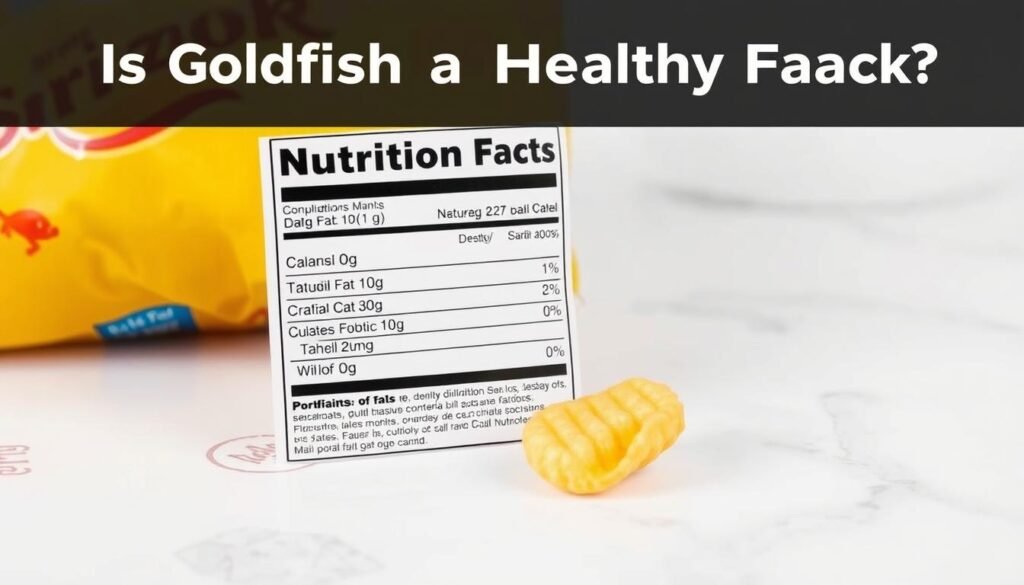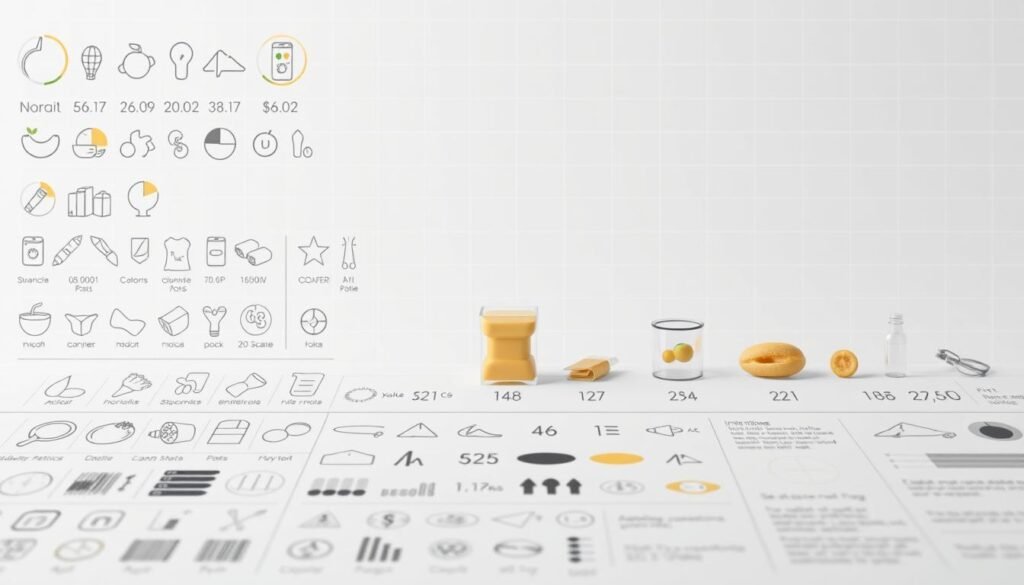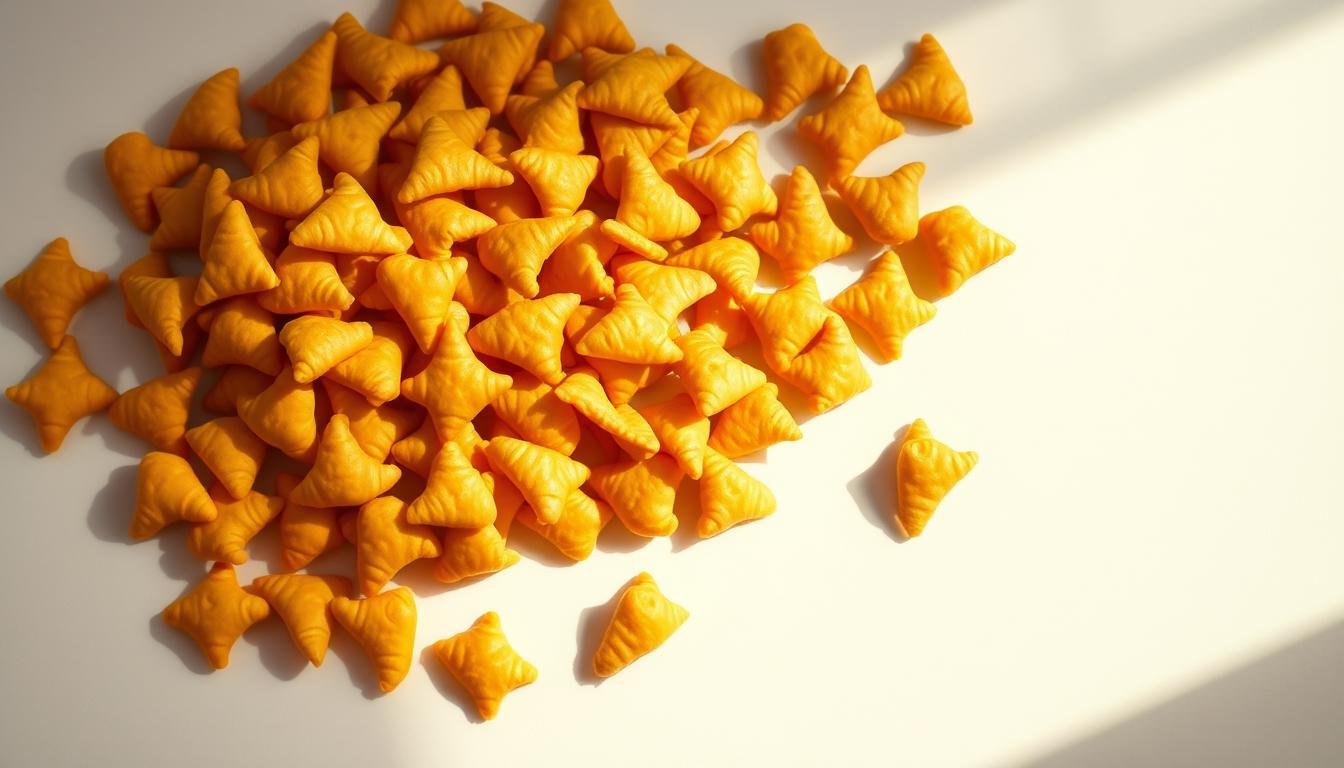Are those smiling fish-shaped crackers secretly undermining your family’s wellness goals? Parents and snack enthusiasts alike often wonder whether this pantry staple deserves its popularity—or if it’s just another processed food in disguise.
Let’s dive into the crunchy details. These bite-sized treats offer quick energy and a small protein boost, making them a go-to for busy households. Unlike sugary alternatives, they contain no added sweeteners, and their simple ingredient list includes enriched wheat flour for essential vitamins like iron and B vitamins.
But here’s the catch: moderation matters. While they’re not packed with superfood nutrients, pairing them with veggies or yogurt can balance snack time. We’ll break down the sodium content, discuss controversial additives, and compare them to other options.
Key Takeaways
- Provides energy from carbohydrates and a modest protein boost.
- Contains no added sugar, unlike many kids’ snacks.
- Fortified with iron and B vitamins for nutritional support.
- Best enjoyed in controlled portions as part of varied meals.
- Ingredient transparency helps families make informed choices.
- Balanced with whole foods to maximize dietary benefits.
Introduction: Evaluating Goldfish as a Snack
Choosing the right munchable options for your family starts with understanding how they fit into daily nutrition. While no single food defines a balanced diet, snacks play a supporting role in keeping energy levels steady between meals. Let’s explore how these crispy, smile-shaped bites stack up nutritionally—and how to enjoy them smartly.

Setting the Stage for a Balanced Diet
Every snack choice matters, but context is key. Processed foods like crackers often lack fiber or protein, which help sustain fullness. However, they can still work alongside fresh fruits, veggies, or yogurt to create satisfying combos. The goal? Build meals and snacks that deliver both enjoyment and nourishment.
Key Nutritional Facts at a Glance
A single serving provides quick energy through carbohydrates and a dash of protein. Unlike many kids’ snacks, these contain no added sugar—a win for parents seeking savory options. Enriched wheat flour adds iron and B vitamins, though they’re not a significant source of whole grains.
Pairing them with fiber-rich apple slices or hummus boosts nutritional value. Moderation remains crucial, as sodium levels can add up quickly. For deeper insights, check our breakdown of Goldfish crackers’ nutritional profile.
Brand Story and Popularity of Goldfish Crackers
What transforms a simple cheese-flavored bite into a cultural icon? For decades, one snack has swum its way into lunchboxes and hearts with a grin. Born in Switzerland in 1958, these crackers began as a playful experiment—combining mild cheddar with a whimsical fish shape. Today, they’re a $1.5 billion-a-year phenomenon, proving that joy sells as much as flavor.
![]()
From “Made with Smiles” to a Household Favorite
The brand’s secret sauce? Emotional storytelling. The “Made with Smiles” tagline isn’t just marketing—it’s a promise. Parents remember munching them as kids, creating a cycle of nostalgia. “We wanted snacks to feel like tiny celebrations,” shares a Pepperidge Farm executive. Bright packaging and cheeky flavors (think Pizza and Cotton Candy) keep the experience lighthearted.
What Makes Goldfish a Recognizable Snack?
Visuals matter. That iconic fish shape isn’t just cute—it’s practical. The design prevents crumbling, making them ideal for tiny hands. Real cheese powder adds a savory punch, while baked-not-fried preparation appeals to health-conscious families. Unlike sugary competitors, they lean into simplicity: wheat, cheese, and a dash of fun.
In a sea of options, this snack thrives by balancing familiarity and innovation. Limited-edition shapes or rainbow-colored varieties spark excitement without straying from its core identity. It’s not just food—it’s a bite-sized companion for road trips, playdates, and “I earned this” moments.
In-depth Analysis: Is Goldfish a Healthy Snack?
When pantry staples face nutritional scrutiny, ingredient lists become roadmaps for smart choices. Let’s unpack what’s inside those cheerful fish-shaped bites and how they fuel your day.

Nutritional Breakdown and Ingredient Insights
A 55-piece serving delivers 140 calories, primarily from carbohydrates (20g) with 3g of protein. Enriched wheat flour—the main ingredient—provides iron (10% DV) and B vitamins like folate. These nutrients support energy levels and red blood cell production.
| Nutrient | Amount per Serving | % Daily Value |
|---|---|---|
| Calories | 140 | 7% |
| Total Carbs | 20g | 7% |
| Protein | 3g | 6% |
| Sodium | 250mg | 11% |
| Iron | 1.8mg | 10% |
Cheddar cheese adds a savory flavor but contributes 1.5g of saturated fat. The absence of added sugar makes these crackers stand out against sweeter alternatives. “Processed snacks aren’t villains if consumed mindfully,” notes dietitian Clara Bennett.
Addressing Common Ingredient Controversies
Canola and sunflower oils—used for baking—contain unsaturated fats but undergo high-heat processing. While safe in moderation, excessive intake might affect cholesterol levels. The refined grain base lacks the fiber of whole grains, though some varieties now include whole wheat flour.
Balancing occasional consumption with fiber-rich foods like veggies offsets limitations. One serving provides 10% of daily iron needs, helping maintain steady energy without spiking blood sugar. Enjoy them as part of varied meals, and your body gets both function and fun.
Whole Grain vs. Regular Goldfish Crackers
Snack shelves overflow with choices, but whole grain claims often spark curiosity. Let’s explore how the whole grain version stacks against classic cheddar favorites—and whether the switch impacts taste or nutrition.
What Whole Grain Brings to the Table
Whole grain Goldfish swap enriched wheat flour for whole wheat as the first ingredient. This adds 2g of fiber per serving versus 0g in regular varieties. The extra fiber supports digestion and helps maintain steady energy levels throughout the day.
However, both versions share similar calorie counts (140-150 per 55 pieces) and protein content (3g). “Choosing whole grain boosts fiber intake without sacrificing convenience,” explains nutritionist Dr. Lisa Tran. Still, they’re not a significant source of vitamins beyond fortified iron and B vitamins.
Nutrition Face-Off: Key Differences
| Nutrient | Whole Grain | Regular |
|---|---|---|
| Fiber | 2g | 0g |
| Added Sugars | 0g | 0g |
| Sodium | 230mg | 250mg |
| Protein | 3g | 3g |
While whole grain options edge out regular in fiber, both remain low in protein and free of added sugars. The iconic cheddar flavor stays consistent across versions, thanks to real cheese powder. For those managing sodium intake, whole grain offers a slight reduction per day.
Pair either option with nuts or veggies to balance macros. Ultimately, choosing between them depends on prioritizing fiber or sticking with the familiar taste that makes Goldfish a lunchbox staple.
Goldfish Crackers and Blood Sugar: Diabetic Considerations
Managing blood sugar doesn’t mean sacrificing favorite snacks—it’s about smart strategies. For those monitoring glucose levels, understanding how foods interact with metabolism is key. Let’s explore how these cheesy bites fit into diabetes-friendly eating plans.
Carbohydrates, Glycemic Index, and Portion Control
A single serving contains 20g of carbohydrates, which directly impact blood sugar. While not excessively high, the amount matters. The glycemic index (GI) of these crackers is moderate, meaning they release energy gradually when eaten in small portions.
Experts suggest limiting servings to 1-2 ounces per snack. Pairing them with protein slows digestion, preventing spikes. For example, adding a handful of almonds balances macros effectively.
Expert Tips for Pairing with Protein and Healthy Fats
Combining carbs with nutrient-dense foods creates balanced snacks. Try dipping crackers in Greek yogurt or pairing with cheese slices. These combinations provide sustained energy and stabilize glucose levels.
Research from PMC studies highlights the importance of managing carbohydrate intake through mindful pairings. One case study showed participants maintaining stable readings by eating 15 crackers with ½ cup cottage cheese.
Remember: individual needs vary. Always consult a dietitian to tailor snacks to your health goals. With thoughtful planning, these bites can be part of a varied, enjoyable diet.
Comparative Review: Goldfish Crackers Versus Other Snacks
Snack time debates often boil down to crunch versus nutrition. Let’s see how these cheesy bites measure up against popular alternatives—and how to elevate their role in your snack rotation.
Goldfish vs. Cheddar Bunnies and Alternative Options
Annie’s Cheddar Bunnies often steal the spotlight with organic ingredients, but how do they compare? Both snacks share similar calorie counts (140-150 per serving), but Goldfish edge out with lower sodium (250mg vs. 280mg). Pretzels, another common choice, lack cheese flavoring but offer marginally more fiber.
| Snack | Serving Size | Sodium | Fiber |
|---|---|---|---|
| Goldfish | 55 pieces | 250mg | 0g |
| Cheddar Bunnies | 51 pieces | 280mg | 1g |
| Cheez-Its | 27 crackers | 230mg | 0g |
| Pretzels | 20 twists | 385mg | 1g |
Cheez-Its pack more cheese flavor per piece but use artificial colors. “Parents prioritize ingredient transparency,” says food blogger Jenna Miles. Goldfish win here with no synthetic dyes. However, whole-grain versions of competing snacks often provide better fiber content.
Snack Pairings for Enhanced Nutritional Value
Transform simple crackers into balanced mini-meals with smart combos. Pair 15-20 pieces with protein-rich almonds or cashews for sustained energy. Add apple slices for natural sweetness and fiber—perfect for hectic afternoons.
Three time-saving tips:
- Mix crackers with raisins and sunflower seeds for a trail mix.
- Serve with hummus or guacamole to boost healthy fats.
- Add a piece of string cheese for calcium and extra protein.
These options work within tight schedules while improving nutrient intake. Even small tweaks, like swapping chips for whole-grain crackers, can make snack time both fun and nourishing.
Practical Tips for Incorporating Goldfish into Your Diet
Smart snacking combines taste and nutrition without the guilt. By focusing on balance and creative pairings, you can enjoy your favorite bites while meeting daily wellness goals. Let’s explore simple ways to make these crispy treats work harder for your routine.
Strategies for Enjoyment Without Overindulgence
Portion control keeps cravings in check. Pre-measure servings into small containers instead of eating straight from the box. A typical portion (about 55 pieces) fits neatly into a ½-cup container—use this as your visual guide.
Pair crackers with protein-rich foods like almonds or cheese sticks. This duo slows digestion, keeping hunger at bay longer. For a sweet-savory twist, add dried fruits like raisins or cranberries to your mix.
Complementary Foods and Snack-Time Balance
Fresh fruits and vegetables add color and nutrients to snack time. Try apple slices with a sprinkle of cinnamon alongside crackers, or serve carrot sticks with hummus for dipping. These combos deliver fiber and vitamins missing in processed snacks.
- Trail mix hack: Combine 15 crackers with pumpkin seeds and dark chocolate chips.
- Yogurt dip: Mix plain Greek yogurt with herbs for a protein-packed dip.
- Veggie stack: Layer cucumber rounds with cream cheese and a cracker on top.
Use a weekly meal planner to schedule snacks alongside whole-food options. Rotating choices prevents boredom and ensures varied nutrient intake. Remember: no single snack defines your diet—consistency over perfection wins every time.
Conclusion
Navigating snack choices can feel overwhelming, but balance is achievable with the right insights. These cheesy crackers deliver quick energy and essential nutrients like iron, though they’re best paired with fiber-rich foods. Whole grain options offer 2g of fiber per serving compared to regular varieties—a small upgrade for digestive health.
For those monitoring blood sugar, portion control remains key. Pairing 15-20 pieces with protein sources like nuts or yogurt helps stabilize energy levels. While each serving contains 1.5g of saturated fat, this amount fits comfortably within daily limits when enjoyed occasionally.
Let’s take a look at practical solutions: pre-portion servings into containers and mix with seeds or veggies for crunch variety. Families seeking deeper insights can explore balanced snacking strategies tailored to busy lifestyles.
Ultimately, no food requires permanent exile from your pantry. Embrace variety, prioritize whole foods, and let take look at your overall dietary patterns. When savored mindfully, these crispy bites become part of life’s flavorful mosaic—not its centerpiece.




